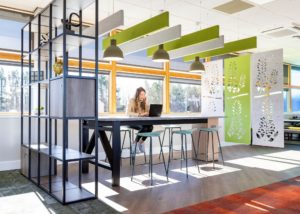Sustainability ranks alongside office attendance as the main topic of discussion in the workplace sector right now. Bringing older, inefficient buildings up to scratch is not just a nice to have, it is a necessity as we seek to meet the Scottish Government’s ambitious carbon reduction targets.
Alongside this, the last few years have significantly shaped staff expectations around workplace flexibility. We know by creating the right workspaces, businesses can bring multiple benefits, from securing and retaining talent, to driving their progress towards net-zero commitments.
We hosted a series of roundtable events, bringing together industry representatives and local business communities to reflect upon the changing industry in the last quarter century and drill down into these key questions such as sustainability in the workplace ideas for the future workplace and the wider built environment.
Clear and consistent communication
The rapid adoption of new ways of working alongside the green agenda have created a new office language, introducing terms like hybrid working.
One confusion with on-trend terminology is around the use of retro-fit and sustainable refurbishment. Both can improve existing buildings to contribute to net-zero goals, whether that’s through improving energy efficiency or conversion to use renewable energy. Attendees at our roundtables highlighted how this terminology is often used inconsistently, leading to confusion and miscommunication. Their conclusion was that the future of the built environment is less about terminology and more about a holistic approach and clarity in communication to enable partnership working that achieves desired outcomes.
Assessing the green credentials of estates
As we reflected on both our own experience and those of our roundtable guests, it became clear that with the combination of rising energy costs as well as the need for flexibility, businesses face a new challenge in aligning their net-zero commitments with the needs of a future-proofed built environment.
Working with aging and inefficient buildings increases the challenge of achieving net-zero emissions targets by 2045. In fact, according to research carried out by Savills, three-quarters of the UK office market falls below the minimum energy efficiency standards which are set to be introduced by 2030.
Knowing how to create a sustainable workplace in order to meet user demand is crucial. But sustainability is only part of the equation; an energy efficient building with the wrong facilities will not work for everyone. It’s also important to proceed with caution when addressing the deficiencies in older buildings as we also need to respect their inherent beauty and charm. Having said that, since efficiency and flexibility are essential, we’d be wrong not to consider replacing buildings that are beyond repair.
Organisations need the support to make the right decisions about implementing sustainability in the workplace ideas and the future of their buildings. With cost implications, tackling every problem is not always feasible and, in a cost of living crisis, efficient use of funds is important. By tapping into data, businesses can achieve valuable insights into the impacts on their sustainability targets, saving or losing money and working for an efficient workforce. Data is a useful driver in planning change.
What’s next for the workplace?
As organisations have changed over the last 25 years in which we have been in business, so has the thinking behind office design. It’s clear in the post-lockdown world that the workplace isn’t going anywhere, but businesses need to focus on designing their spaces for sustainability and flexibility, inspiration and a whole range of scenarios none of us can forecast. Looking back to pre-pandemic offices with utilisation levels of sub 50%, organisations are now heeding their environmental responsibility of having a right sized workspace that also stacks up commercially.
To achieve this, organisations have to balance challenges and needs. Achieving them and creating the ideal sustainable workplace for the future is not straightforward, which is where working with a skilled workplace consultancy can make decisions easier. So many businesses are at different stages of their journey and no one solution fits all – the only way to progress and meet the challenges is through taking the time to listen, review and plan, while considering that every project, however small, plays its part in creating our current and future built environment.

